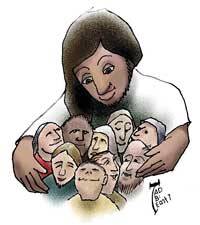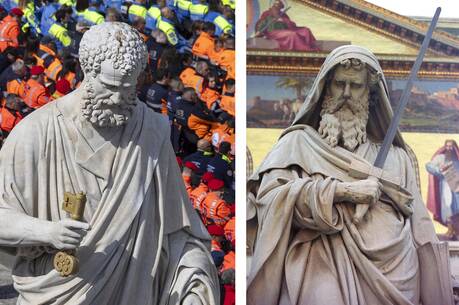Anointed in Truth
The reading from Acts is set in the upper room, where the disciples are gathered between the ascension and Pentecost. About 120 persons are there (1:15), a symbol for the full number of disciples. In the preceding verse, Luke lists as present the Twelve along with the women, presumably Mary Magdalene, Joanna, Susanna and the many others (Lk 8:1-3) who came up to Jerusalem and witnessed the crucifixion (Lk 23:49), saw Jesus laid in the tomb (Lk 23:55-56) and discovered it empty (Lk 24:1-9). Jesus’ mother and his siblings are also there. All are present except Judas. We can hear the pain and disillusionment of the early community as the members struggled to explain how one who was “numbered among us and was allotted to share in this ministry” could have ended as the guide for those who arrested Jesus. As always, the Scriptures provide the assurance that God is not absent even during these most horrific moments, even if they do not fully explain such tragic happenings.
In the first chapter of Acts, Peter emerges as spokesperson for the community. It is a turbulent time of transition and they rely on the form of leadership with which they are familiar. This is the last time that the Twelve are reconstituted; a replacement is not chosen for James when he is killed by Herod (Acts 12:1). As the narrative progresses, the patterns of leadership shift. The Twelve disappear from the story after 6:2; Peter is not mentioned again after 15:7. James and the elders emerge as the leaders of the community in Jerusalem (12:17; 15:13; 21:18), and Paul takes center stage in the mission to the Gentiles.
In the Gospel, we have the middle section of Jesus’ prayer during the Last Discourse. We are meant to overhear this intimate conversation between Jesus and the Father so that we can be encouraged by the legacy bequeathed to us. Jesus addresses God as “Father,” the one who in a patriarchal culture is responsible for protecting the whole household. Jesus has embodied this protective care of his disciples. His strong arms enwrapped them, like a father who fends off all threats to his children’s well-being, or a mother who enfolds her little ones, shielding them from all harm.
Just as Jesus has been consecrated for mission, so he prays for the consecration of his followers. “Consecrated” means to be anointed and set apart for mission, not in the manner of kings whose anointing separates them from the realities of ordinary people, but in the truth, which immerses Jesus’ disciples into the heart of the struggles of all their fellow creatures in “the world.” While kings are anointed on the head to great acclaim, disciples of Jesus are “anointed” in footwashing, set apart for self-surrender in love for one another, particularly those who would seem most unlovable. This is the oil of truth that flows over the heads of Jesus’ disciples, consecrating them in the protective mantle of “the name” and “the word.” Just as Jesus’ anointing by Mary (12:1-11) strengthened him to face death, the consecration of his followers allows them to face hostility and hatred as the birthpangs that give way to complete joy in new life (17:13; 16:20-23).
This article also appeared in print, under the headline “Anointed in Truth,” in the May 18, 2009, issue.








